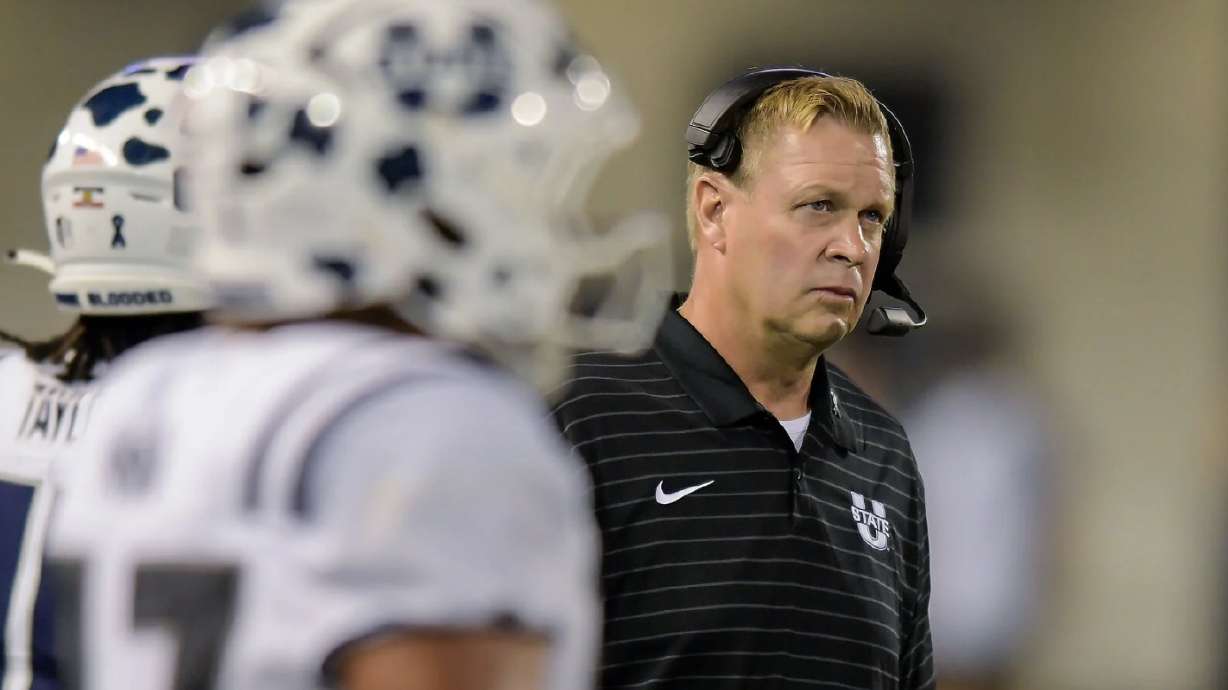LOGAN — There were many questions for Utah State entering its matchup with Hawaii.
Two of the most notable questions were surrounding the Aggies’ pass defense and pass protection, neither of which had been impressive in the previous loss to Vanderbilt or in most of the games this season.
Despite having an additional week to prepare for Hawaii after a bye week, neither of those questions were resolved in Saturday’s loss to the Rainbow Warriors. In fact, far more questions were raised by the overall effort.
The Aggies came into the game ranked 75th of 134 FBS teams in passing yards allowed per game, averaging 226 passing yards allowed per game. Hawaii had 284 passing yards and three passing touchdowns by halftime and finished with 413 passing yards.
Hawaii connected on two deep passes early in the game, but it was primarily the short and medium yardage passes that gave the Aggies fits.
“Obviously, some coverages we have little weak spots or to the back, they like to throw the little quick game,” said senior defensive tackle Gabriel Iniguez. “They’ve done this against any other team, so they get the quick game out to the boundary quick.”
That same attack worked against Utah State.
On top of that, Hawaii got after the Utah State backfield all night, tallying three sacks, four tackles for loss, and seven quarterback hurries. One of the sacks came late in the second quarter and knocked out starting quarterback Bryson Barnes (he re-entered the game in the second half), and one quarterback hurry forced a late interception.
Utah State entered the game ranked 133rd in sacks allowed, allowing 3.8 sacks per game, playing right into what Hawaii hoped to do all night.
“Hawaii was very disruptive up front and pressuring the quarterback, playing physical in the run, beating blocks, making tackles,” head coach Bronco Mendenhall said. “When our quarterback did elude pressure and was scrambling and fighting for first downs, the holding penalties — the number of holding penalties, and when they were happening, and how they were happening — showed up quite a bit.”
Through five games, Barnes has looked like a legitimate Mountain West offensive player of the year candidate, and the backfield of BYU transfer Miles Davis and Javen Jacobs has looked formidable.
But outside of winnable games at home against UTEP, McNeese and Air Force, there hasn’t been much to point to and claim as improvement from the struggles a season ago.
In fact, it’s unknown if this year’s Aggies squad was truly good before Saturday night. It appeared as if the team was moving in the right direction and building some momentum, but that momentum came screeching to a halt in Saturday’s loss.
Not only was the Aggies defense and secondary exposed, while allowing 44 points and nearly 550 total yards, but the previously strong offense found itself flailing in the second half, too. After finding the end zone on their first possession of the second half from a gifted short field, the Aggies were shut out the rest of the way.
As the Rainbow Warriors continued to move the ball with ease and put up points, the Aggies offense kept grasping for air, constantly looking for big plays and chunk yardage to no avail with increasing frequency.
“They got up on us, and we were trying to find a spark,” Davis said. “We started trying to do some big plays, but it didn’t go our way. We’ve just got to go — we’ve got a lot to do and work on as an offense.”
Other underlying concerning trends including penalties and a lack of third-down conversions, which were again prevalent Saturday. The team finished with 11 penalties for 73 yards and went 2-of-12 on third downs.
“The technical part, the tactical part, and just basically the execution, is a focus point of emphasis,” Mendenhall said. “I would argue that it was and has been improving. Today, I think, clearly, it took a step backwards and really allowed Hawaii to be disruptive.”
After a 4-8 season with an interim head coach at the helm, the 2025 season had some optimism about it with a familiar name being hired as the head coach.
But as Utah State returns home for a shortened week and a homecoming game bout with San Jose State, many of those optimistic feelings have been muted as a realization sets in for the expectations of Mendenhall’s 2025 squad.
The Key Takeaways for this article were generated with the assistance of large language models and reviewed by our editorial team. The article, itself, is solely human-written.

